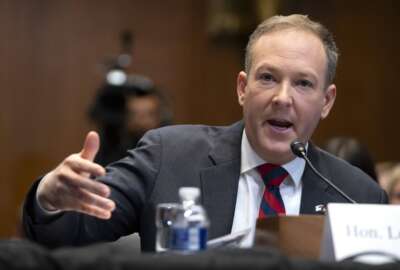Shrinking GAO budget concerns employees, oversight advocates
The Government Accountability Office issues hundreds of reports each year detailing billions of dollars in cost-savings. Its role is considered essential to the...
wfedstaff | April 17, 2015 3:35 pm
When the Government Accountability Office released its 400-page volume on duplicative and potentially wasteful government programs in February, lawmakers praised the investigative and auditing agency for being watchful stewards of taxpayer money.
But just a few weeks later, the head of GAO, Comptroller General Gene Dodaro, went before a Senate appropriations subcommittee, hat in hand, to ask an increasingly skeptical Congress for a modest increase in the agency’s funding for next year.
| Experts weigh in on GAO’s budget |
 |
| Gene Dodaro, U.S. Comptroller General Testifying before Senate subcommittee
|
 |
| Ron La Due Lake, president, GAO Employees Union On 2012 funding
|
 |
| John Palguta, vice president for policy, Partnership for Public Service On the agency’s budget constraints
|
Last fall, GAO faced the prospect of steep budget cuts for the current fiscal year, after the same Senate committee proposed cutting the agency’s budget by as much as $50 million — a more than 9 percent reduction.
GAO escaped the deepest cuts, instead taking a $35 million hit. Even so, the agency is on track to have fewer than 3,000 full-time employees by the end of the year, nearly rock-bottom staffing levels it hasn’t seen since the 1930s.
In his testimony on the agency’s budget, Dodaro said the diminishing staff levels would result in “missed opportunities” for the agency to identify cost-savings and efficiencies “at a time when the country needs us most.”
That message — that long-term cuts and a smaller staff would ultimately impact the effectiveness of GAO’s work and thus congressional oversight — is one echoed by Ron La Due Lake, the president of the GAO Employees Union.
“Overall, there’s concern about how we can continue to provide the valuable and essential information that we do to Congress, if the size of our workforce continues to decrease,” he said.
While agencies across the federal government are facing cuts and shrinking workforces, GAO may be unique.
The watchdog agency has drawn admiration from both Democrats and Republicans and consistently ranks high on a list of the best places to work in the federal government. Its work, providing audits and evaluations of a broad array of federal programs, is considered an essential part of the congressional oversight process. The agency estimates it saved the federal government $45.7 billion last year, which represents a return-on-investment of $81 for every dollar spent on GAO.
GAO seeks to rebuild staff
GAO officials declined to comment on the agency’s current budget situation. There are ongoing hearings about its official request for next year.
In its 2013 request, the agency sought $526.2 million — 2.9 percent, or about $15 million, above current levels.
“The majority of the requested increase represents the first step in rebuilding our staff capacity to a level that will enable us to optimize the benefits we yield for the Congress and the nation,” Dodaro said in a statement attached to the proposed budget.
But at a March 15 Senate hearing on legislative branch funding, Sen. Ben Nelson (D-Neb.), the chairman of the subcommittee, said, “Unfortunately, given the budgetary battles ahead of us, any growth in budgets very well may be too much growth.”
In particular, Nelson questioned why GAO had offered buyouts and early retirements last year only to turn around and ask for more funding to pay for staff increases.
Dodaro said the decision to offer early outs to about 60 employees, was a “prudent” one in the short term, in order to avoid furloughs or layoffs.
“The staffing request is with an eye toward the future, of building the capacity of GAO in order to have the knowledgeable and skilled workforce that we need in order to serve the Congress,” Dodaro said. And the agency, which has faced declining budgets since a high in 2010, has taken a number of steps to cut administrative costs and spending on contractors, he added.
Bureaucrats or watchdogs
Last year, the Senate subcommittee surprised many when it proposed the deep cuts to GAO’s 2012 funding. The 9 percent cuts were deeper even than those offered by the equally deficit-hawkish House.
La Due Lake said it was the first time he could remember the Senate mark coming in lower than the House’s, which employees found “stunning.”
“We didn’t understand … if it was a process that led to that, just in terms of adding up the numbers, or if there was a specific message,” he said. “It raised a lot of concern.”
The Senate’s proposed funding made it clear to employees the climate of cutbacks would not spare GAO.
“Cuts won’t be easy and agency by agency, there will be resistance,” Nelson was quoted in the Omaha World-Herald in November before 2012 appropriations were finalized. “I intend to put the interests of Nebraska taxpayers ahead of Washington bureaucrats and make cuts where we can.”
But the characterization of Congress’ top watchdogs as mere bureaucrats had some lawmakers, including Sen. Tom Coburn (R-Okla.), crying foul.
“If the mission of GAO is compromised by excessive cuts, where else can Congress turn to find unbiased data to improve programs and save money?” Coburn wrote in the introduction to a 30-page report, “Shooting the Messenger: Congress Targets the Taxpayers’ Watchdog,” that his office released in response to the 2012 budget proposals.
“Even with a shrinking budget, GAO has continued to produce nearly 1,000 reports a year recommending billions of dollars in savings,” Coburn wrote, contrasting it with a dwindling number of congressional hearings.
At “the very time Congress most needs GAO to help navigate the difficult budgetary choices ahead … Congress is dealing the taxpayers’ watchdog a blow,” he added.
A spokesman for Nelson’s office said GAO’s budget had climbed in recent years, and the Senate proposal represented a decrease over the growth period, or an evening out of funding over the past couple of years. The spokesman also said the proposed budget number reflected bipartisan agreement between Nelson and the subcommittee’s ranking member, Sen. John Hoeven (R-N.D.).
Employees concerned about staffing levels
Even as GAO escaped the worst budget cuts this year, employees remain concerned about what could happen if Congress tightens the purse strings again — especially their affect on staffing levels, La Due Lake said.
“We’ve not been hiring almost at all,” he said. “The last year we hired a few people in some critical positions, but very few. The year before was not a very big hiring year. And people continue to leave the organization for routine reasons. … So the workforce just keeps getting smaller and smaller.”

GAO is adamant that adverse appropriations or reduced staff won’t have an impact on the quality of its reports — only the volume and perhaps the timeliness with which it delivers them.
“We will never sacrifice quality,” Dodaro told Senate appropriators last month. “It’s too important to the decisionmaking of the Congress to do that.”
But amid the agency’s budget woes last fall, some commentators pointed to the cautionary tale of a former agency: the Office of Technology Assessments.
Created in 1972, the OTA was a respected but somewhat obscure congressional office tasked with researching how technology impacted American society and institutions.
The agency’s esoteric mission collided with an influx of Republican lawmakers intent on shrinking government. In 1995, lawmakers voted to dismantle the agency.
But John Palguta, the vice president of policy for the Partnership for Public Service, said comparisons between GAO’s downsized budget and the defunding of OTA are not apt.
“My sense is that certainly some members of Congress are looking at every option to reduce the deficit … but not to the point they’re getting rid of their investigative arm, their analytical arm,” he said, referring to GAO. “So I think it’s really squeezing, trying to get as much toothpaste out of that tube but without totally running out of toothpaste,” he added. “I really don’t think GAO’s in any danger of going out of existence.”
Still, Palguta said the push to reduce GAO’s budget, irrespective of the cost-saving work it does, is “penny-wise, pound foolish.”
GAO employees sense ‘external’ pressure
In February, more than 300 members of GAO’s administrative staff voted to join the International Federation of Professional and Technical Engineers, partnering with the GAO Employees Union that the agency’s analysts had voted to form in 2007.
La Due Lake said he thought a “sense of vulnerability” about the budget played at least some part in that decision.
When GAO analysts voted five years ago to join a union for the first time in the agency’s history, it was largely driven by internal tensions at the agency, Palguta said. Former Comptroller General David Walker had proposed changes to the employee pay structure that meant some would go without annual raises.
“Now, it’s not so much what’s happening internally, but what’s happening externally to the budget,” he added.
To stave off reductions-in-force or the closing of field offices this year, union and management agreed to trim some of the agency’s other benefits, La Due Lake said, including lower merit-pay increases. Against the union’s wishes, the agency also cut its student loan repayment program, which La Due Lake said is important in recruiting and retaining particularly younger employees.
“Between those two things … some people have left the agency for other positions where they could earn more money,” he said.
GAO’s 2013 budget request spells out an increased staff level of 3,250 employees.
At the recent Senate appropriations hearing, lawmakers asked Dodaro whether the agency had undertaken a thorough review of the size of its workforce — a “right-sizing.”
Dodaro said any examination of his workforce must encompass the demand for reports the agency continues to receive from lawmakers.
“Right now, we can’t meet all the demands from Congress in a timely fashion to meet everybody’s needs,” he said.
Check out the rest of our special GAO series:
- GAO’s evolving role: From accounting to accountability
- What goes into a GAO report? Expert insight into the process and timeline of an investigation
Copyright © 2025 Federal News Network. All rights reserved. This website is not intended for users located within the European Economic Area.





